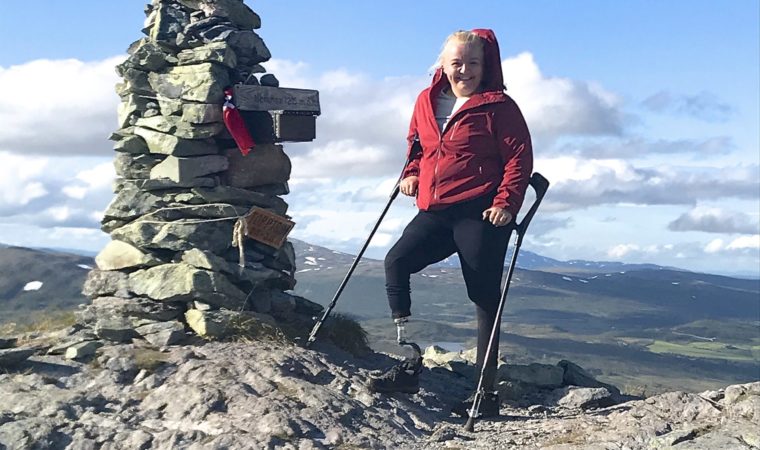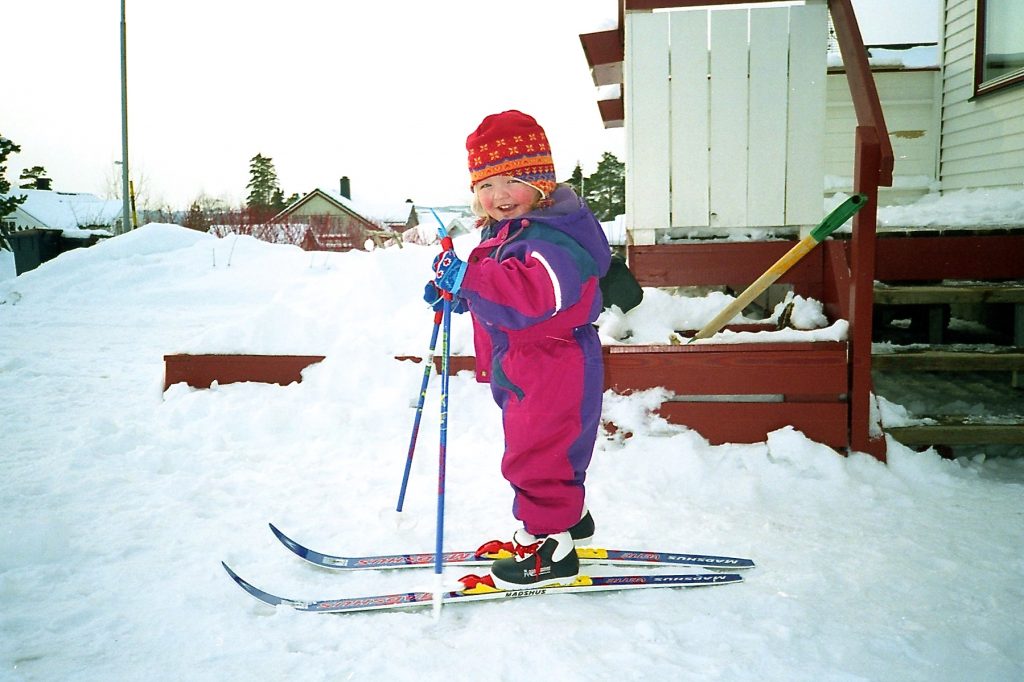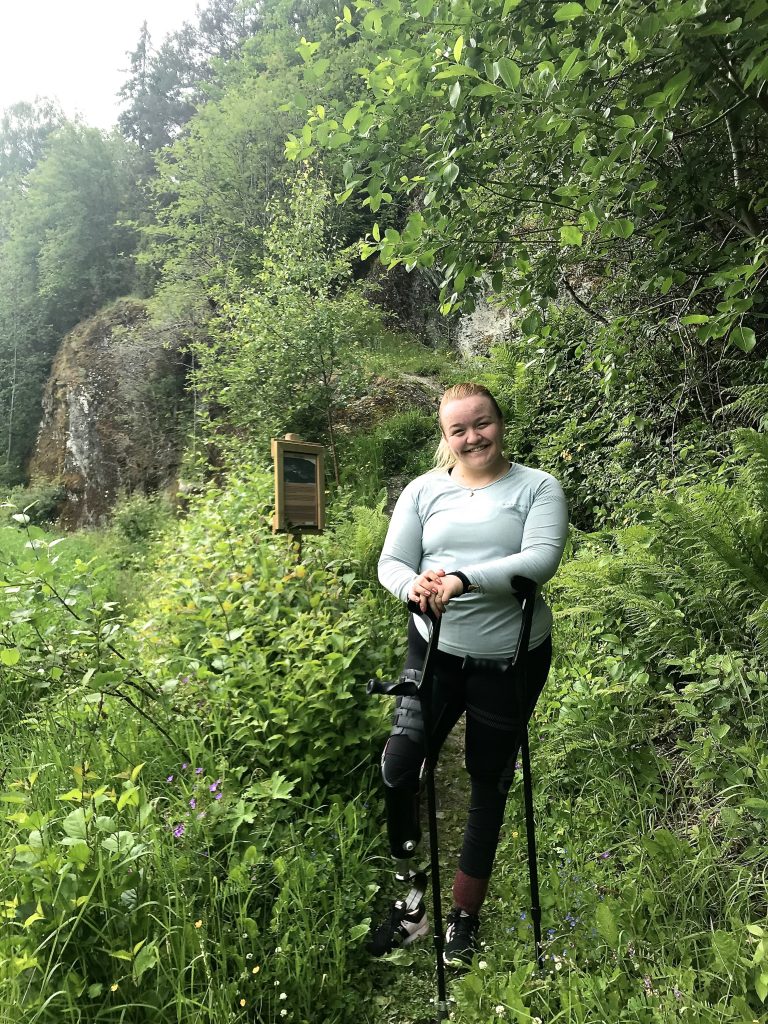Dysmelia has given Anita an advantage as an orthopedic engineer

Anita Hellan was born with dysmeli, without the foot from the ankle on the left foot, as well as the leg from the calf on the right leg. Here she has brand new cross country skis, February 1999. By Marte Nordahl. Photo, private. – I know well how good and bad prostheses affect my quality […]

By Marte Nordahl. Photo, private.
– I know well how good and bad prostheses affect my quality of life. I use all the experiences I have gained in my new job as an orthopedic engineer, says Anita Hellan.
Anita Hellan, 24, from Sparbu in Steinkjer, was born with dysmeli without the foot from the ankle on the left foot, as well as the leg from the calf on the right leg.
– It has been completely nice and natural for me to grow up without two legs. Nevertheless, it has not been completely painless, says Anita, who at times has felt pain on her body. The pain is mainly due to a lot of strain.
Early prosthesis user
Anita got her first prosthesis on her right leg as a one-year-old to even out the leg difference. The prosthesis made her able to get up. At just 17 months, she started wearing prostheses on both legs.
– It has first and foremost been very positive to use prostheses. Nevertheless, I have experienced getting prostheses that have not fit well. The prerequisite for getting a correct prosthesis has been to find an orthopedic engineer with whom I have good chemistry and who understands me, she says.
Choose the workshop yourself
Previously, Anita has experienced that some workshops have not informed her that she is free to choose her own workshop.
– It was Momentum who informed me that it is actually allowed to choose a workshop yourself. Over the years, I have therefore tested different workshops, where some have worked better than others, she informs.
Impaired quality of life
In her teens, she experienced having prostheses that did not fit at all and that gave her great pain. As a result, she was close to becoming a wheelchair user.
– I was very inactive and lay a lot straight out. I was tired and bored and it was not exactly tempting to use the prostheses. At the time, I thought it would be like that, says Anita.
Various prostheses
Today, Anita uses activity prostheses that have made her more active. The practical arch at the bottom of the prosthesis means that she gets a good kick, so that she can go for longer walks. Anita is happy that she gets a nice trip during the week.
– I enjoy walking short steep walks in the woods and fields, so that I can use my body and feel that my heart rate rises. This summer I went on a very tough mountain hike up Nonshøa in Oppdal, at 1210 meters. I walked for a full 3.5 hours and am very proud to reach the very top, says Anita who usually does not go long walks due to the pain in her legs.
Pain that disappears
The pain that Anita has grown up with she has more or less come to expect. Anita herself uses the dentures all day from early in the morning until late in the evening. Naturally, it is also felt on the body.
– The positive thing is that I usually know when the pain occurs. After the walk in Oppdal I got hurt for two days afterwards. I do not think it does as much when I am aware of it. I get pain in the stumps after a lot of standing still and walking which fortunately disappears quickly. Therefore, I am extra careful to take good breaks.
As a 22-year-old, Anita also thinks it was great to be able to run for the very first time with a new running prosthesis. Due to a bad knee, she has currently put the running aside with the hope of being able to run again later. Today, she actively trains strength and spinning at a local fitness center.
Knee surgery
Due to the dysmelia, the anatomy in Anita’s right knee is underdeveloped, which causes it to slip out of joints when she performs activities. After several knee surgeries over the years, the running worked for a while, until the knee went out of joint again.
– Besides running, the knee works very well. I am happy that I am finally able to go for walks, she says.
Momentum member all his life
Anita Hellan has been a member of Momentum since she was born. Her mother and father attended gatherings via Momentum when she was young.
– I feel very lucky to have grown up with a family that has not treated me any differently than my four year older brother. They have been very open about my disability to everyone around me. As a result, I do not care when people around me stare. I also think it is positive that curious people ask me questions about my prostheses. Curious young people get answers to what they are wondering about, she says.
Nice upbringing
Anita knew no one who had dysmeli growing up. On the other hand, she became acquainted with someone with the same diagnosis on a rehabilitation stay at the age of eight at Sunnaa’s competence center for rare diagnoses.
– I also remember well the information meeting at the primary school together with a physiotherapist and my parents in front of the other students in the class. Here I inform them about my own situation. When I took off the prosthesis in front of the other students, someone fainted, says Anita, who otherwise experienced her childhood and adolescence as pleasant.
Prosthesis without cosmetics
Anita, on the other hand, has felt that it has been challenging not to be able to do things that everyone else has managed. During her teenage years, she was also more concerned with hiding her prostheses by using a cosmetic prosthesis.
– Today I no longer use cosmetics on the prostheses. Since the prosthesis does not look like a real foot, you can clearly see that I am a prosthesis user. I think it may help that it is more common to see a prosthesis user, she says.
New view of life
Anita has gained a different outlook on life by using dentures. She has become stronger mentally and copes better with challenges. Small problems do not become as big since she has other challenges to contend with.
– I can still feel a little alone as a prosthesis user even though I know that there are many who use one. That is why Momentum has been good to rely on. They have also helped me to realize that I am not alone. It is also nice to meet people of all ages who use dentures and who are in the same situation as you. In Momentum, we share experiences and knowledge with each other, she says.
Helps other prosthesis users
Anita took a peer-to-peer course in Tønsberg three years ago with a desire to help other amputees and prosthesis users further. Here she met several prosthesis users.
– So far I have had several conversations that I think have been incredibly rewarding. Since I started a new job in June this year at Østo Ortopedisenter at Tiller in Trondheim, it is a bit challenging to have different roles as both prosthesis user, peer and orthopedic engineer. I need time to find my own thing, she says excitedly.
Peer course
Anita plans to work more as an equal as she has adapted to the new job.
– I also have plans to participate in several events and weekend trips under the auspices of Momentum. Due to school and studies, I have not been able to participate as much as I wanted. The actual study time has been very nice and tough with a lot of practical work and a lot of walking and standing. It has been three nice and demanding years, she says.
Hijacked the dream job
All the experiences she has gained come in handy as a newly qualified orthopedic engineer and as a peer.
– I thrive extremely well in my new job as an orthopedic engineer. Østo Orthopedic Center at Tiller has a very good professional and social environment, she says with satisfaction.
Anita has dreamed of becoming an orthopedic engineer for as long as she can remember. She knows well how good and bad prostheses affect the quality of life. Her experience will have a positive effect in the profession where she has a good understanding of how the user is doing.
– An orthopedic engineer has a broad knowledge, both medical and technical. Here I get to work both practically and with people, she says happily.
Bright future
Anita is optimistic about the future. She is looking forward to continuing in her new job. She has also bought an apartment that is ready to move into this autumn.
– I already see that my experience as a prosthesis user comes in handy at work. I look forward to helping other users of an orthopedic aid, she says happily.











